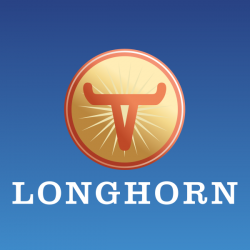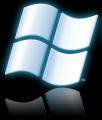Windows Longhorn
- For post-reset history and builds, see Windows Vista.
 |
|
| Windows "Longhorn" | |
| Codename Preliminary name |
Longhorn |
|---|---|
| Kernel version | NT 6.0 |
| CPU architecture | x86, x64, IA-64 |
| Release date | N/A |
| Support end | N/A |
| Preceded by | Windows XP |
| Succeeded by | Windows Vista |
Longhorn was the codename for the planned successor of Windows XP.
One of the original - and largest - changes is that, with "Longhorn", the .NET Framework would be integrated into the core Windows platform, deprecating the traditional Win32 API. During development, portions of the operating system were rewritten, causing memory leaks and instability, particularly in Windows Explorer.
Development was reset, but post-reset builds continued to use the "Longhorn" codename until the final name, Windows Vista, was announced on 22 July 2005.
History
Codename
"Longhorn" was chosen as the codename for the operating system to represent its initial status as an internim release between Windows XP (codenamed "Whistler") and "Blackcomb". Whistler and Blackcomb are names of mountains in British Columbia, Canada,[1][2] and Longhorn is the name of a saloon located in between the two mountains, representing the operating system's initial status as an internim release between the two products.[3] Bill Gates would later state that this choice for a codename of the operating system was "a bit random".[4]
Codebase

The popular belief is that pre-reset "Longhorn" builds are based on Windows XP. This was likely spurred by Paul Thurrott's statement on his review of build 5048: "The problem, I was told recently, was that the underpinnings of Longhorn--then based on the Windows XP code base--were struggling under the weight of all of the technologies that Microsoft planed to implement in this release."[6] However, pre-reset "Longhorn" builds are based, not on XP, but on Windows Server 2003 code.[5] The xpclient release branch, dedicated to XP, spun off from the main branch in 2001. The main branch continued to compile Server 2003 builds at the 3xxx range, such as build 3663 (release candidate 1), until the dnsrv branch dedicated to Server 2003 spun off from the main branch in 2002. After that, the main branch began compiling Longhorn builds.[7]
Mark Lucovsky, Microsoft Distinguished Engineer and Windows Server Architect, explained to Thurrott in 2003:
The mechanics of doing this are mind-numbing. [...] We have a main branch of code for the current Windows version, and that branch becomes the source base for hot-fixes and the next service pack. Once we spit out a service pack, that becomes a branch and now we have two branches we have to test for hot-fixes and service packs. We can't tell customers to install, say, SP1 and then do this hot-fix. And this is going on for every [Windows] release, so some have 2 or 3 service packs, many hot-fixes, and many security fixes. Every one of these is a managed collection of 50 million lines of code. It's a pretty big accounting issue.
— Mark Lucovsky, Paul Thurrott's Windows Server 2003: The Road To Gold Part Two: Developing Windows, [5]
Logos
Several different logos were created throughout the development of "Longhorn". Early builds used 2D and 3D representations of a longhorn bull; later builds included white or glass versions of the Windows flag.
Concepts, presentations, demos and prototypes
- Earliest concepts (2002, 2003)[8]
- MSX "Longhorn Days" (2003)
- Amazon.com demo (PDC 2003)
- Get Users to Fall in Love With Your Software - Hillel Cooperman's demo from PDC 2003 (video)
- Business solutions enabled by Longhorn technologies by Carter Maslan (2004, mockups only)[9]
Implementation of concepts
Twitter user Lucas Brooks (mswin_bat) found that porting the private Milestone 7 Aero theme to a Milestone 5 build like 4017 enables the striped sidebar shown in a demo.[10]
Builds
- For server builds, see the Windows Server 2008 page.
- No information available
- Existence doubtful
- Information or pictures available
- Leaked or released
Lab guide (Source: Grabberslasher)[11]
- Lab01: Base (Kernel)
- Lab02: Networking
- Lab03: Server
- Lab04: Management
- [Lab05:] Main
- Lab06: Desktop
- Lab07: IIS/COM+
Milestone 1&2
Planning stage. No builds known.
Milestone 3
- 3663.0.Lab06_N.020728-1728
- 3670.0.Lab06_N.020819-1749
- 3683.0.Lab06_N.020923-1821
- 3706.0.Lab06_N.021029-1731
- 3708.0.Lab06_N.021108-1847
- 3713.0.Lab06_N.021113-1841
- 3718.0.lab06_N.021119-1730
Milestone 4
- 4000
- 4001.0.main.021204-1515
- 4002.0.Lab06_N(ntvbl06).030108-1926
- 4005.0.main.030128-1920
- 4006.0.main.030203-1038
- 4008.0.main.030219-1933
- 4011.0.main.030305-2045
Milestone 5
- 4015.0.main.030328-1500
- 4015.0.Lab06_n.030403-1706
- 4017.0.main.030409-0735
- 4018.0.Lab06_n.030417-1721
- 4020.0.idx02.030430-2218
- 4020.0.idx02.030507-1155
- 4029.0.main.030619-0000
- 4030.0.main.030626-1414
- 4031.0.main.030703-0020
Milestone 6
- 4029.0.Lab06_n.030629-1710
- 4030.0.Lab06_n.030630-1724
- 4030.0.Lab06_n.030702-1727
- 4031.Lab06_n.030707-1834
- 4032.0.Lab06_n.030710-1709
- 4033.0.main.030717-1555
- 4033.0.idx01.030730-1630
- 4038.0.main.030813-1852
- 4039.0.Lab06_n.030824-1954
- 4039.0.Lab06_n.030827-1717
- 4040.0.Lab04_N.030828-1910
- 4042.0.main.030905-1800
Milestone 7
- 4042.0.Lab06_n.030909-1709
- 4044.0.Lab06_n.030915-1925
- 4048.0.idx02.030925-1900
- 4050.0.idx02.030928-0552
- 4050.0.private/lab06_demo.031018-2015
- 4050.0.private/lab06_demo.031019-1809
- 4050.private/lab06_demo.031021-2041 (build tag may not be accurate)[12]
- 4050.private/lab06_demo.031022-1924[13]
- 4051.0.idx02.031001-1340
- 4053.0.main.031022-1720
- 4067.0.private/lddm_dev_tech(davidmo).040212-1646
- 4067.0.idx01.040312-1730
- WinHEC 2004 Aero demo build
- 4074.0.idx02.040425-1535
- 4081.0.main.040503-1625
- 4082.0..main.040510-2230
- 4083.0.main.040516-1537
- 4084.0.main.040527-0915
- 4085.0.main.040603-1817
- 4085.0.Lab07.040609-2350
- 4086.0.main.040615-1745
- 4086.0.lab03_dev.040629-1910
- 4086.0.lab01_n.040704-2000
- 4087.0.main.040626-0846
- 4088.0.Lab02_N.040706-1655
- 4089.0.private_lab06_dev_ux.040721-1800
- 4093.0.main.040819-1215
- 4093.Lab02_N.041002-1235
Development reset
- See Windows Vista.
References
- ↑ Whistler Vacation Tips. "Windows Blackcomb: See Why Bill Gates Loves Whistler"
- ↑ Thurrott, Paul. "Windows 'Longhorn' FAQ"
- ↑ Thurrott, Paul. "Road to Gold: The Long Road to Windows Vista Part 1: 2001-2001"
- ↑ Levy, Steven. (November 23, 2003). "He's Still Having Fun"
- ↑ 5.0 5.1 5.2 Thurrott, Paul (8 February 2003). Windows Server 2003: The Road To Gold Part Two: Developing Windows. Archived from the original on 11 February 2003. Retrieved on 29 October 2023.
- ↑ Thurrott, Paul (5 May 2005). Windows Longhorn Build 5048 Review. Archived from the original on 6 May 2005. Retrieved on 2 April 2022.
- ↑ The Experience Longhorn Project. The very beginning. Retrieved on 27 October 2023.
- ↑ Thurrott, Paul (20 August 2003). Windows Longhorn "Aero" Gallery. Paul Thurrott's SuperSite for Windows. Archived from the original on 22 August 2003. Retrieved on 18 November 2023.
- ↑ http://web.archive.org/web/20040520183754/http://blogs.msdn.com:80/jcmaslan/archive/2004/04/09/110645.aspx
- ↑ Lucas Brooks (@mswin_bat) (14 February 2022). Microsoft actually implemented a lot of the crazy stuff seen in their Longhorn concepts. The private Aero theme was all that's needed to get this lovely striped taskbar/sidebar in M5. Picture on the right shows the M5 port of the M7 Aero theme.. Twitter. Retrieved on 16 April 2022.
- ↑ Grabberslasher (9 June 2008). Longhorn Labs. Si vis pacem, para bellum. Retrieved on 18 April 2022.
- ↑ XenoPanther (8 January 2022). Avalon: Building Tools and Controls Using Design-Time Services (PDC 03). YouTube. Retrieved on 27 October 2023.
- ↑ XenoPanther (8 January 2022). WinFS: Schemas, Extensibility and the Storage User Experience (PDC 03). YouTube. Retrieved on 27 October 2023.
See also
- Athens PC
- WinHEC 2003
- PDC 2003
- WinHEC 2004
- Windows Sidebar
- Desktop Composition Engine (Longhorn)
- Desktop Window Manager
- Friendly Fire
- Self-Host Vote
- Next-Generation Secure Computing Base
- WinFS
BetaArchive forum
- The Longhorn Kernel-Mode Timebomb
- Aborted Longhorn concepts/features
- Windows "Longhorn" features present in Windows Vista
- ReflectiaX's Longhorn Beta and Demo Files Thread!
Development reset
External links
Microsoft
- The Pillars of Longhorn
- The Road to Windows "Longhorn" (last updated 13 November 2002)
- The Pillars of Longhorn: Living La Vida Longhorn (Longhorn Foghorn)
- The Long Road to Windows Vista (Part 1), 18 October 2006
- Avalon
- Indigo
- Introducing Indigo: An Early Look, February 2005 (May 2005 version from the authors' site)
- Longhorn Developer Center Home: User Experience (Aero)
- A First Look at Writing and Deploying Apps in the Next Generation of Windows
- Jim Allchin - The Longhorn Update
Paul Thurrott's SuperSite for Windows
- The Road to Windows "Longhorn" (last updated 13 November 2002)
- The Long Road to Windows Vista (Part 1), 18 October 2006
- Paul Thurrott's SuperSite for Windows: The Road to Windows "Longhorn" (last updated 13 November 2002)
Longhorn.ms
- Aurora & Aero | Microsoft Longhorn
- Hacking Avalon – 1: Disable it
- Hacking Avalon – 2: Port it | Microsoft Longhorn
- Hacking Avalon – 3: Compiling xaml
- Managed C++ and the Longhorn Shell
- .NET framework
- Startpage
- Help center
Other non-Microsoft
- UX.Unleaked Grabberslasher's blog that describes several unleaked "Longhorn" builds
- Jim Allchin’s Mac message: The full text (leading up to the reset)
- Longhorn Rumors: What's true and what isn't — WinWorld
- Document Preview : General Windows Support
- Retro: Windows Longhorn - Nerdshack
- Code name: Longhorn by John Clyman, PC Mag article
- Microsoft Shows New Features of Windows Longhorn (PCWorld article from 5 May 2004 about WinHEC 2004)
- Indigo: The Longhorn Communications Layer (Figure 1)
- Code Red: Battling Google, Microsoft Changes How It Builds Software, 23 September 2005




